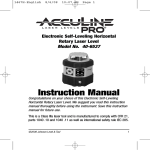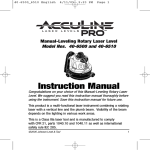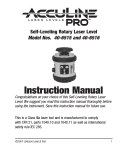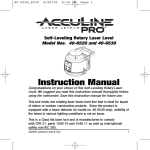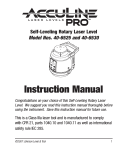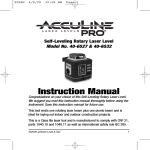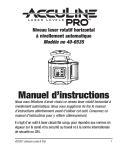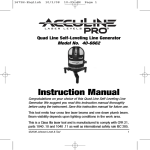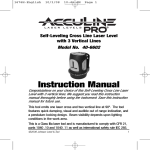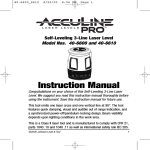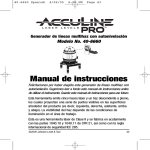Download AccuLine 40-6505 Instruction manual
Transcript
™ Manual-Leveling Rotary Laser Level Model Nos. 40-6500, 40-6505 and 40-6510 Instruction Manual Congratulations on your choice of this Manual-Leveling Rotary Laser Level. We suggest you read this instruction manual thoroughly before using the instrument. Save this instruction manual for future use. This is a Class IIIa laser tool and is manufactured to comply with CFR 21, parts 1040.10 and 1040.11 as well as international safety rule IEC 285. ©2007 Johnson Level & Tool 1 Table of Contents 1. Kit Contents 2. Features and Functions 3. Safety Instructions 4. Location/Content of Warning Labels 5. Location of Parts/Components 6. Operating Instructions 7. Using the Product 8. 9. 10. 11. 12. 13. 14. Self-Check Technical Specifications Application Demonstrations Care and Handling Product Warranty Product Registration Accessories 1. Kit Contents 2 For Model No. 40-6500 Description Manual-Leveling Rotary Laser Level “AA” Alkaline Batteries 6V Battery Adapter Tinted Glasses Instruction Manual with Warranty Card Soft-sided Carrying Case Qty. 1 4 1 1 1 1 For Model No. 40-6505 Description Manual-Leveling Rotary Laser Level “AA” Alkaline Batteries 6V Battery Adapter Tinted Glasses Remote Control with 9 Volt Battery Instruction Manual with Warranty Card Soft-sided Carrying Case Qty. 1 4 1 1 1 1 1 ©2007 Johnson Level & Tool For Model No. 40-6510 Description Qty. Manual-Leveling Rotary Laser Level 1 “AA” Alkaline Batteries 4 6V Battery Adapter 1 Multi-Functional Mount with Carrying Case 1 Remote Control with 9 volt Battery 1 Detector with 9 volt Battery and Clamp 1 Tinted Glasses 1 Magnetic Target 1 Portable Elevating Tripod with Carrying Case 1 Instruction Manual with Warranty Card 1 Soft Sided Carrying Case 1 2. Features and Functions • Emits a horizontal laser plane. • Emits a vertical laser plane with simultaneous 90º split beam. • Emits a line perpendicular to rotating plane, to form laser cross line movable by 360 degrees. • Large and small range scan modes achieve a chalk line. • Scan line can be moved clockwise or counter-clockwise. • Variable rotation speed. • Integral Slope Dial 3. Safety Instructions Please read and understand all of the following instructions, prior to using this tool. Failure to do so, may void the warranty. CAUTION: If using this product with any type of tinted goggles, please note safety warning below. ©2007 Johnson Level & Tool 3 DANGER! Class IIIa Laser Product Max. Power Output: ≤ 5mW Wavelength: 625-645nm THIS TOOL EMITS LASER RADIATION. DO NOT STARE INTO BEAM. AVOID DIRECT EYE EXPOSURE. ATTENTION IMPORTANT • Read all instructions prior to operating this laser tool. Do not remove any labels from tool. • Do not stare directly at the laser beam. • Do not project the laser beam directly into the eyes of others. • Do not set up laser tool at eye level or operate the tool near a reflective surface as the laser beam could be projected into your eyes or into the eyes of others. • Do not place the laser tool in a manner that may cause someone to unintentionally look into the laser beam. Serious eye injury may result. • Do not operate the tool in explosive environments, i.e. in the presence of gases or flammable liquids. • Keep the laser tool out of the reach of children and other untrained persons. • Do not attempt to view the laser beam through optical tools such as telescopes as serious eye injury may result. • Always turn the laser tool off when not in use or left unattended for a period of time. • Remove the batteries when storing the tool for an extended time (more than 3 months) to avoid damage to the tool should the batteries deteriorate. • Do not attempt to repair or disassemble the laser tool. If unqualified persons attempt to repair this tool, warranty will be void. • Use only original AccuLine Pro™ parts and accessories purchased from your AccuLine Pro authorized dealer. Use of non-AccuLine Pro parts and accessories will void warranty. WARNING! The tinted goggles are designed to enhance the visibility of the laser beam. They DO NOT offer protection to the eyes from direct exposure of the laser beam. 4 ©2007 Johnson Level & Tool 4. Location/Content of Warning Labels ©2007 Johnson Level & Tool 5 5. Location of Part/Components Rotating Laser Output Aperture X-Level Vial 90º Split Beam Output Aperture Operating Panel Z-Level Vial (Vertical) Vertical Laser Output Window X/Z-Leveling Knob Slope Adjusting Knob Y-Level Vial Y-Leveling Knob Battery Door Mounting Bracket DC 6V Power Jack 6 5/8" – 11 Thread ©2007 Johnson Level & Tool 6. Operating Instructions IMPORTANT: It is the responsibility of the user to verify the calibration of the instrument before each use. Battery Installation Note: Always check to be sure that the on/off switch is in the off position before removing and replacing batteries. 1. Turn the instrument 90 degrees. 2. Remove the battery door. 3. Put in four AA alkaline batteries into the battery compartment, noting polarity (as shown). 4. Snap the battery door back into place. Note: Do not charge alkaline batteries to avoid explosion. Used (discharged) batteries are hazardous waste and should be disposed of properly. Instrument Usage Horizontal Instruction 1. Put four “AA” alkaline batteries into the instrument or power the instrument by connecting DC 6V through power jack. 2. Mount the instrument on a 5/8" –11 tripod. 3. Make sure that the slope adjusting knob is at 0. 4. Adjust the leveling-knob to center the bubble of both vials in X and Y axis. ©2007 Johnson Level & Tool 7 Level Vial Adjusting Method X/Z-Leveling Knob 5. Turn the instrument on and then start operation. 6. Turn off the unit after operations. Note: Make sure that the grade adjusting knob points to 0 8 Y-Level Knob Rotating Laser Line Grade Adjusted by Grade Adjusting Screw ©2007 Johnson Level & Tool Vertical Instruction 1. Put four “AA” alkaline batteries Rotating Z-Direction into the instrument or power Laser Line Leveling Knob the instrument by connecting DC 6V through power jack. 2. Put the instrument on platform or a 5/8" –11 tripod. 3. Adjust the leveling-knob to center the bubble of vial in Z axis. 4. Turn the instrument on and then start 90º Split Laser operation. Beam 5. Turn off the unit after operations. Slope Instruction The slope function is available when the instrument is in the horizontal position. The operating details are shown as follows: 1. Put the instrument on a platform or tripod. 2. Aim the Y-axis of the instrument in the desired slope direction. ©2007 Johnson Level & Tool Slope is performed in the y axis 9 3. Turn the grade adjusting knob to tilt the level vial in the Y-direction to desired grade (0%~4%) (fig. 1). Figure 2 4. Level the vial with the leveling knob (fig. 2). Figure 1 Slope 5. Start operation (fig. 3). Figure 3 Gradient (0-4%) Horizontal 6. Power off the unit after operations, and turn the grade adjusting knob to the 0 position. (fig. 4). Figure 4 Marking Line Instruction Note: Level the instrument. When the instrument is rotating, press the power switch once to activate the vertical line function. Now the instrument will form a cross with the rotating laser and vertical laser. Turn the instrument to move the vertical laser. The vertical laser can be positioned within a 360 degree range. Figure 5 illustrates this feature. 10 ©2007 Johnson Level & Tool Turn the instrument to move the vertical laser to a different position Horizontal Laser Line Vertical Laser Line Figure 5 7. Using the Product Operating Panel 1. Power/Vertical Line Button 2. Scan Mode Button 3. Rotation Speed Down Key/Clockwise 4. Rotation Speed Up Key/Counterclockwise 5. Power Light 6. Scan Mode Indicator Light Power On/Off • Power On: With the first press of the power button, the rotating laser and plumb-beam are turned on. Power indicator light is also turned on. The power indicator light will flash when batteries are low. ©2007 Johnson Level & Tool 11 1st Press 2nd Press 3rd Press Power/Vertical Line On Power ON Power Off Press Again • Vertical Line On: With a second press of the power button, the vertical laser is also turned on. • Power Off: A third press of the power button, turns all of the lasers and power indicator lamps off. Rotation / Scan Mode • High Speed Rotation: When turned on, the instrument is in the high-speed rotation mode. This is indicated by the range scan indicator light (continuously on), and rotating laser in high speed. 1st Press 2nd Press Small Range Scan Press Again High Speed Rotation 4th Press Large Range Scan DOT 3rd Press • Small Scan: With one press of the scan mode button, the rotating laser performs scan at a small angle. The scan indicator light will blink. • Large Scan: With a second press of the scan mode button, the rotating laser performs scan at a large angle. The scan indicator light will blink. • DOT: With a third press of the scan mode button, the rotating laser stops and projects a laser dot. The scan indicator light will blink. 12 ©2007 Johnson Level & Tool Up/Down Key • In high-speed rotation mode, pressing the key will increase the rotation speed. Pressing the key will decrease the rotation speed. Note: The instrument rotates in highest speed when it is initially powered on. • In scan mode, pressing the key shifts the scan counterclockwise. Pressing the key shifts the scan clockwise. Remote Control Usage (included in Model No. 40-6505 & 40-6510) Operating Panel 1. Rotation speed up/counter-clockwise 2. Scan button 3 2 3. Rotation speed down/clockwise 4. Power Button 1 4 Power Button • The power button on the remote control is to turn the laser off. It will not turn the laser on as it is important that the operator of the laser levels or checks the vials prior to operating. Rotation Speed Down • The down button will slow down the rotation speed of the laser when the laser is in its full rotation mode. • When the laser is in the scan mode, this button will rotate the scan line clockwise. Rotation Speed Up • The up button will increase the rotation speed of the laser when the laser is in its full rotation mode. • When the laser is in the scan mode, this button will rotate the scan line counter-clockwise. ©2007 Johnson Level & Tool 13 Scan Button • Pushing the scan button once will change the laser from full rotation to a small scan. The scan mode indicator light will flash on the laser. • Pushing the scan mode button again will change the laser into its large range scan. • Pushing the scan button a third time will change the laser beam to a dot. • Pushing the scan button a fourth time will change the laser back to its full rotation mode. The scan mode indicator light on the laser will remain constant. Detector Usage (included in Model No. 40-6510) 1. Technical Specifications Detecting precision Fine: ±0.039" (±1mm) Coarse: ±0.098" (±2.5mm) Turn-off timer 10 minutes Three types of sound Size 6.614" x 2.677" x 0.905" (168 X 68 X 23mm) 2. Components (a) Structure 1. Display window 2. Horn 3. Receiving window 4. Reference rabbet 5. Horn button 6. Coarse/Fine detection button 7. Power button 8. Threaded hole 9. Battery-box cap 14 ©2007 Johnson Level & Tool (b) Display 1. Power symbol 2. Low battery symbol 3. Coarse/Fine detection symbol 4. Horn symbol 5. Detecting position symbol 3. Operation Guide (a) Installation of battery • Open the battery-box cap and connect the cords inside with the two polarities of the 9V battery. Note: Take the battery out if the instrument if not used for a long time. • Put the 9V battery into the battery box and close the battery-box cap. (b) Turn on/off • Press the on/off button. When Power symbol is displayed, the instrument is ready for coarse detection. • When low battery symbol is displayed, change the battery. • Press the on/off button again to turn off the instrument. ©2007 Johnson Level & Tool 15 (c) Using the clamp holder 1. grade rod clamp bolt 2. detector connection screw • Attach the detector on the clamp holder by the detector connection screw. • Attach the grade rod clamp to the grade rod or other types of surveying rods by tightening the clamp bolt on the grade rod clamp holder. (d) Detection 1. Coarse detection • Aim the receiving window at the rotating laser instrument. Loosen the clamp bolt and move the detector up and down to receive the laser signals transmitted by the rotating laser instrument. • When the instrument displays like Fig. (A), move the instrument down as indicated by the arrow. When it displays like Fig. (B), move it up as indicated by the arrow. • When Fig. (C) is displayed, the detector is level with the laser beam. 16 ©2007 Johnson Level & Tool 2. Fine detection 1. power symbol 2. fine detection symbol Figure 6 • Press coarse/fine detection button. The detector is now in fine detection. • Move the instrument up and down like the coarse detection procedure. (e) Horn • Press the horn button. The sound symbol is displayed and the horn is ready for the sound function. The detector then conducts coarse/fine detection through sound (beep) signals. • When the horn signal is a fast beep, move the detector up. • When the detector makes short beep, move it down. • When the detector makes a continuous sound, it is level with the laser beam. • If there is no beep heard, the instrument has not received the laser beam signal. (f) Turn-off timer • The detector will automatically turn off if it has not received a laser signal for 10 minutes (g) Detector Maintenance • When you are done using the detector, return it to its case. • Keep the instrument, particularly the detecting window, clean. If unit becomes dusty, use a clean cloth to gently wipe it clean. ©2007 Johnson Level & Tool 17 • Avoid knocking the unit over or allowing it to fall on the ground. • Although the instrument is rain resistant, you should avoid submerging the unit in water or other liquids. If unit comes into contact with water or other liquids, wipe it dry immediately. • Do not use unit around fire or expose it to fire in any way. 8. Self-Check IMPORTANT: It is the responsibility of the user to verify the calibration of the instrument before each use. Level Vial Self-Check A. X/Y-Direction Level Vial Self-Check 1. Fix the instrument on a platform or a tripod. A tripod with level vial is preferable. 2. Center the bubbles of X/Y-direction vials by adjusting the leveling knob. 3. Turn the instrument by 90° 3 times to observe whether the bubbles are centered at all position, the instrument is now level. B. Z-Direction Vial Self-Check 1. Put the instrument with adjusted X/Y-direction vials on tripod 3 feet (1m) from wall A, and level the 3’ 50’ laser. Project laser beams to wall A and wall B respectively, and mark the laser points shown on walls as e1 and f1. 18 ©2007 Johnson Level & Tool 2. Put the instrument in the vertical position on the tripod. 3. Face the instrument towards wall A, and adjust the leveling knob to center the bubble of Z-direction vial. Project laser beam and mark e2 for the laser point shown on wall A. 4. Measure the distance between e1 and e2. 5. Turn the instrument 180° to face wall B, and turn the adjusting knob and mark the laser point projected on wall B f2. 6. The distance between e1 and e2 should equal the distance between f1 and f2. Instrument Accuracy Self-check 1. Put the instrument on a tripod in the center of two parallel walls that are 50 ft. apart, with the instrument facing left, as shown. Aim the instrument at wall A and wall B respectively to project the laser beams, and mark point a1 and point b1 for the laser points shown on walls. 2. Move the instrument 3 ft. (1m) from wall A and level it, with the front still facing left. Repeat step 1, and mark the projected red laser points as a2 and b2; ©2007 Johnson Level & Tool 19 3. Measure the distance between a1 and a2, and between b1 and b2. If the distance between a1 and a2 + b1 and b2 is greater than 1/8” at 50 ft.,the accuracy is beyond tolerance, reference section 12 of this document. 9. Technical Specifications Laser Wavelength Laser Classification Maximum Power Output Accuracy Interior Range Exterior Range Remote Range Slope Power Supply Battery Life Dimensions Weight Working Temperature Center Screw Thread Rotation speeds Scanning mode (degrees) IP Protection Class 20 635nm±10nm Class IIIa ≤5mW ±1/4"/100 ft. (±2mm/10m) Up to 200 ft. (60m) diameter depending upon light conditions Up to 800 ft. (240m) diameter with detector Up to 400’ (120m) diameter with remote 4º 4 “AA” alkaline batteries or 6V battery adapter Approx. battery life 25 hours continuous use 5.3258" x 4.75" x 6" (136x120x153mm) 1.5 lbs. (0.7Kg) 14°F to 113°F (-10°C to +45°C) 5/8" – 11 150-300 rpm 0, 30, 60 43 ©2007 Johnson Level & Tool 10. Application Demonstrations Ceiling installation Anti-static flooring installation Window installation Baseboard installation Hanging pictures Dormer installation ©2007 Johnson Level & Tool 21 11. Care and Handling • This laser unit is a precision tool that must be handled with care. exposing unit to shock vibrations and extreme temperatures. • Before moving or transporting the unit, make sure that the unit is turned off. • Remove the batteries when storing the unit for an extended time (more than three months) to avoid damage to the unit should the batteries deteriorate. • Always store the unit in its case when not in use. • Avoid getting the unit wet. • Keep the laser unit dry and clean, especially the laser output window. Remove any moisture or dirt with a soft, dry cloth. • Do not use harsh chemicals, strong detergents or cleaning solvents to clean the laser unit. • Avoid 12. Product Warranty Johnson Level & Tool offers a one year limited warranty on each its products. You can obtain a copy of the limited warranty for a Johnson Level & Tool product by contacting Johnson Level & Tool's Customer Service Department as provided below or by visiting us online at www.johnsonlevel.com. The limited warranty for each product contains various limitations and exclusions. Do not return this product to the store/retailer or place of purchase. Required repair/calibration must be done by an authorized AccuLine Pro™ service center or Johnson Level & Tool's limited warranty, if applicable, will be void and there will be NO WARRANTY. Contact our Customer Service Department to obtain a Return Material Authorization (RMA) number for return to an authorized service center. Proof of purchase is required. 22 ©2007 Johnson Level & Tool NOTE: The user is responsible for the proper use and care of the product. It is the responsibility of the user to verify the calibration of the instrument before each use. For further assistance, or if you experience problems with this product that are not addressed in this instruction manual, please contact our Customer Service Department. In the U.S., contact Johnson Level & Tool’s Customer Service Department at 800-563-8553. In Canada, contact Johnson Level & Tool’s Customer Service Department at 800-346-6682. 13. Product Registration Enclosed with this instruction manual you will find a warranty card to be completed for product warranty registration. Product warranty registration can also be completed online at our web site www.johnsonlevel.com. You will need to locate the serial number for your product that is located on the bottom of the instrument. PLEASE NOTE THAT IN ADDITION TO ANY OTHER LIMITATIONS OR CONDITIONS OF JOHNSON LEVEL & TOOL'S LIMITED WARRANTY, JOHNSON LEVEL & TOOL MUST HAVE RECEIVED YOUR PROPERLY COMPLETED WARRANTY CARD WITHIN 30 DAYS OF YOUR PURCHASE OF THE PRODUCT OR ANY LIMITED WARRANTY THAT MAY APPLY SHALL NOT APPLY AND THERE SHALL BE NO WARRANTY. ©2007 Johnson Level & Tool 23 14. Accessories AccuLine Pro™ accessories are available for purchase through authorized AccuLine Pro dealers. Use of non-AccuLine Pro accessories will void any applicable limited warranty and there will be NO WARRANTY. If you need any assistance in locating any accessories, please contact our Customer Service Department. In the U.S., contact Johnson Level & Tool’s Customer Service Department at 800-563-8553. In Canada, contact Johnson Level & Tool’s Customer Service Department at 800-346-6682. 24 ©2007 Johnson Level & Tool
























